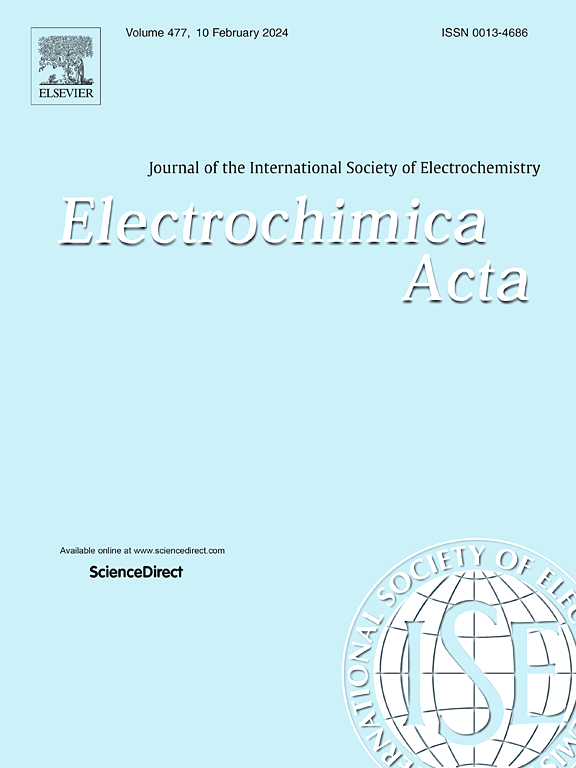Enhanced oxygen reduction reaction using polyoxometalates as mediators in near neutral electrolytes for zinc-air batteries
IF 5.5
3区 材料科学
Q1 ELECTROCHEMISTRY
引用次数: 0
Abstract
The quest for effective and sustainable energy storage solutions has led to the exploration of devices like Metal-air batteries, whose performance heavily depends on the efficiency of electrocatalysts in oxygen reduction reactions (ORR) at the cathode. Zinc-Air batteries (ZABs) are a great option, since its components are low cost, safe and eco-friendly. Despite significant efforts, creating cost-effective electrocatalysts with high activity for ORR remains a major challenge. Furthermore, most of the research in the ORR field is carried out in highly alkaline electrolytes, which allow for favorable ORR kinetics but lead to corrosion and low durability of the catalysts and the cells. This work explores the possibility to use polyoxometalate clusters as homogeneous (i.e. in solution) catalysts/mediators in near-neutral pH, evidencing an alternative path to facilitate ORR. Several cobalt containing POMs with Keggin (K5H[Co2+W12O40], K8[Co2+Co2+(H2O)W11Co2+O40]·15H2O, K7 [Co3+Co2+(H2O)W11O39]·14H2O), Dawson (K12[Co2+(H2O)H2P2W12O48]) or Superlacunary (K12Li16Co2+2[Co2+4(H2O)16P8W48O184]) nanocluster, were used in solution showing significant activity on the ORR. The unique existence of redox processes for both Co and W moieties within the cluster suggests the possibility of bifunctional electrocatalysis, and redox mediation with a potential impact in aqueous rechargeable metal-air batteries operating in near – neutral media. The electrochemical action of easily reduced soluble POM clusters on ORR shows an increased activity when the Co-substituted Keggin POMs are dissolved at pH 5. Keggin based structures containing Co offer optimal kinetic parameters, as compared with POMs based on Dawson structures, with the possible involvement of the tetrahedral Co present in the former.
以多金属氧酸盐为介质在近中性锌空气电池电解质中增强氧还原反应
对有效和可持续的能量存储解决方案的追求导致了对金属-空气电池等设备的探索,其性能在很大程度上取决于阴极氧还原反应(ORR)中电催化剂的效率。锌空气电池(ZABs)是一个很好的选择,因为它的组件成本低,安全和环保。尽管付出了巨大的努力,但为ORR制造高性价比、高活性的电催化剂仍然是一个重大挑战。此外,ORR领域的大多数研究都是在高碱性电解质中进行的,这有利于ORR动力学,但会导致催化剂和电池的腐蚀和低耐久性。这项工作探索了在接近中性的pH值下使用多金属酸氧酯簇作为均相(即溶液)催化剂/介质的可能性,证明了促进ORR的替代途径。用Keggin (K5H[Co2+W12O40]、K8[Co2+Co2+(H2O)W11Co2+O40]·15H2O、K7 [Co3+Co2+(H2O)W11O39]·14H2O)、Dawson (K12[Co2+(H2O)H2P2W12O48])或superlacary (K12Li16Co2+2[Co2+4(H2O)16P8W48O184])纳米团簇的几种含钴pom在ORR上表现出显著的活性。簇内Co和W基团氧化还原过程的独特存在表明双功能电催化的可能性,以及在近中性介质中工作的水相可充电金属-空气电池中具有潜在影响的氧化还原中介。当共取代Keggin聚甲醛在pH值为5时,易还原的可溶性聚甲醛团簇在ORR上的电化学活性增加。与基于Dawson结构的POMs相比,基于Keggin的含有Co的结构提供了最佳的动力学参数,前者中可能存在四面体Co。
本文章由计算机程序翻译,如有差异,请以英文原文为准。
求助全文
约1分钟内获得全文
求助全文
来源期刊

Electrochimica Acta
工程技术-电化学
CiteScore
11.30
自引率
6.10%
发文量
1634
审稿时长
41 days
期刊介绍:
Electrochimica Acta is an international journal. It is intended for the publication of both original work and reviews in the field of electrochemistry. Electrochemistry should be interpreted to mean any of the research fields covered by the Divisions of the International Society of Electrochemistry listed below, as well as emerging scientific domains covered by ISE New Topics Committee.
 求助内容:
求助内容: 应助结果提醒方式:
应助结果提醒方式:


